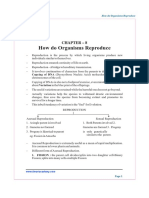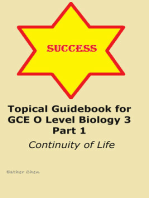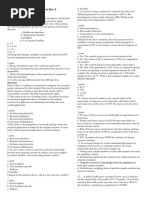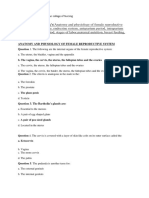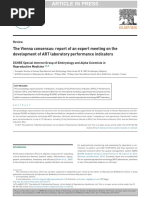0 ratings0% found this document useful (0 votes)
5 viewsGeneral Biology Reviewer
General Biology Reviewer
Uploaded by
coyeecoigenbio
Copyright:
© All Rights Reserved
Available Formats
Download as DOCX, PDF, TXT or read online from Scribd
General Biology Reviewer
General Biology Reviewer
Uploaded by
coyeecoi0 ratings0% found this document useful (0 votes)
5 views6 pagesgenbio
Original Title
General-Biology-Reviewer (1)
Copyright
© © All Rights Reserved
Available Formats
DOCX, PDF, TXT or read online from Scribd
Share this document
Did you find this document useful?
Is this content inappropriate?
genbio
Copyright:
© All Rights Reserved
Available Formats
Download as DOCX, PDF, TXT or read online from Scribd
Download as docx, pdf, or txt
0 ratings0% found this document useful (0 votes)
5 views6 pagesGeneral Biology Reviewer
General Biology Reviewer
Uploaded by
coyeecoigenbio
Copyright:
© All Rights Reserved
Available Formats
Download as DOCX, PDF, TXT or read online from Scribd
Download as docx, pdf, or txt
You are on page 1of 6
General Biology Reviewer
Plants and animals are living 1. Stolon
organisms that feed, respire, 2. Tuber
excrete, grow, move, and 3. Rhizome
4. Buds on Leaf
reproduce. Animals consume
other organisms for energy, while Sexual Reproduction in Plants
plants use photosynthesis. Angiosperms, or flowering
Animals usually reproduce plants, are common
sexually, whereas many plants worldwide and primarily
can reproduce both sexually and reproduce sexually through
asexually. their flowers.
Sexual reproduction takes
place in the sexual organs
of the flower.
Sexual Asexual MALE FLOWER REPRO.
Reproducti Reproducti Stamen- Male reproduction
on on organ in plants
No. of 2 1 Anther – Makes ting grains called
parents “pollen”
involved Filament- holds the anther
Gamete Sperm has No gamete
s to fertilize union FEMALE FLOWER REPRO:
the egg Carpel- female repro.
Genetic Hybrid of Geneticall Stigma- sticky surface to trap
composi Parents y identical pollen
tion of (kaliwat) (clone) Style- joins stigma and ovary
offsprin Ovary – contains female sex cells
g (ovules)
Pollination- pollen transfer from
Reproduction is what’s anther to stigma
unconsciously goal of every Double Fertilization- other way,
organisms do. fruits with seeds
Monocot- one cotelydon
Asexual Reproduction in Dicot- two cotyledon
Plants
Asexual Reproduction in
Genetically identical to their Animals
parent plants. Common among simpler
Through vegetative organisms like protists,
reproduction. New plants cnidarians, hydra, and
grow from modified stems amoeba, as well as some
or specialized structures complex animals.
Offsprings are identical to
(e.g., runners, tubers,
the parent in
corms, and rhizomes). characteristics.
Types of Asexual
Sexual reproduction in
Reproduction in Plants:
Animals
General Biology Reviewer
Sexual reproduction 2. Spawning or mating-
involves the formation of bringing gametes together
new individuals from sex 3. Fertilization- fusion of
cells or gametes produced gametes (external fertilization or
by parents in their sexual internal fertilization)
organs. Animals like cnidarians develop
The majority of these temporary reproductive organ
animals are dioecious, known as gonads during fall
meaning they have (mating season).
separate sexes.
Human Reproduction
Why asexual reproduction is also
called as ‘clonal reproduction’? - Consists of two components
Because offspring are identical to – main reproductive organs
the parent cell. and accessory organs.
Both have a pair of gonads
Three mechanism how asexual (testis and ovaries)
reproduction mitosis occur to containing germ cells that
unicellular organism showing will give rise to mature sex
the exact copy of the parent: cells or gametes.
1. Fission – involves the division Three weeks after
of body into two or more equal fertilization, about one-
parts. fourth of the inner surface
of the uterus becomes a
2. Budding – a new individual spongy tissue made up of
arises as an outgrowth (bud) from endometrium and
its parent. embryonic membranes,
3. Fragmentation – the body known as the chorion.
breaks into two or more parts, Male Reproduction System
with each
• Testis – produce sperm cells
Parthenogenesis - This modified
process of sexual reproduction • Scrotum– pouch-like sac that
holds the testis
results in a complete offspring
from unfertilized eggs. • Penis – places sperms into the
vagina during mating
• Vas deferens - transports
mature sperm to the urethra, the
tube that carries urine or sperm
Sexual reproduction in to outside of the body, in
animals occurs in three preparation for ejaculation.
fundamental steps:
• Glands - Provide liquid in which
1. Gametogenesis - production sperm can swim
of gametes
General Biology Reviewer
a. Seminal vesicle -
Secretes one of the
components of the semen Phases of the Menstrual Cycle
b. Prostate gland - 1. MENSTRUATION
Secretes a milky fluid that is
discharged into the urethra The uterus lining sheds and
as part of the semen. flows out through the
vagina, containing blood,
c. Bulbourethral gland -
mucus, and cells.
Mucous secreting glands
located at the base of the Average duration: 3 to 7
penis. days.
Female Reproductive System 2. FOLLICULAR PHASE
The female reproductive Begins on the first day of
system has the following menstruation, lasting 13 to
functions: 14 days.
Hormone changes thicken
1. Production of female sex cells
the uterus lining and
2. Reception of sperm cells from
stimulate follicle growth;
the male.
usually, one follicle matures
3. Nurturing the development of,
into an egg.
and providing nourishment for,
the new 3. OVULATION
Individual
A mature egg is released
from an ovary, typically
• Ovary - produces egg cells
occurring about 2 weeks
• Oviduct - passageway of eggs
before the next period.
from the ovary to the uterus (also
Highest chance of
where the egg is fertilized).
pregnancy with unprotected
• Uterus - place where fertilized
sex around this time.
egg develops.
• Vagina - receives the penis of 4. LUTEAL PHASE
male during mating.
The egg travels through the
fallopian tubes to the
MENSTRUAL CYCLE - a monthly uterus; the lining continues
process in a girl’s body that to thicken for potential
prepares for pregnancy. It pregnancy.
typically lasts about 28 days and If pregnancy occurs, no
has four phases: period; if not, menstruation
begins again.
1. Menstruation
2. Follicular Phase Human and Growth
3. Ovulation Phase Development
4. Luteal Phase.
General Biology Reviewer
Fertilization begins with the 2. Endometriosis: Condition
fusion of sperm and egg where endometrial tissue
cells to form a fertilized egg grows outside the uterus,
called a zygote. causing pain and potentially
A series of cell divisions affecting fertility.
occurs as the zygote travels 3. Polycystic Ovary
down the fallopian tube to Syndrome (PCOS):
the uterus, taking about 6 Hormonal disorder affecting
to 7 days. ovary function and
The zygote, resembling a menstrual cycle.
ball of cells, attaches to the 4. Prostate Disorders:
endometrium in a process Conditions like benign
called implantation. prostatic hyperplasia (BPH)
Once attached, the zygote or prostate cancer in males.
is referred to as an embryo.
The embryo/fetus develops
in the uterus for about 9 5. Miscarriage: The
months until it is ready for spontaneous loss of a fetus
birth. before the 20th week of
pregnancy
Embryonic and Fetal
Development Top 3 Morbidity Related to the
Reproductive System
Three weeks after
fertilization, about one- 1. Maternal Morbidity:
fourth of the inner surface Health conditions like
of the uterus becomes a anemia and preeclampsia
spongy tissue made up of that arise during pregnancy,
enometrium and embryonic leading to potential
membranes, known as the complications if not properly
chorion. managed.
This tissue allows the 2. STIs: Infections like
placenta and the embryo to gonorrhea and chlamydia
receive nutrients and harm reproductive health if
oxygen from the mother untreated.
while also removing waste 3. Infertility: Fertility issues
products. caused by hormonal or
structural problems impact
5 COMMON HEALTH ISSUES
reproductive health.
RELATED TO THE
REPRODUCTIVE SYSTEM Top 3 Mortality Related to the
Reproductive System
1. Infertility: Inability to
conceive after regular 1. Maternal Mortality:
unprotected intercourse. Pregnancy and childbirth
General Biology Reviewer
complications, like B. Diaphragm - an
hemorrhage and infections, attractive birth control
cause maternal deaths. alternative for women to
2. Neonatal Mortality: avoid the hormonal
Newborn deaths within 28 impact of injections or
days, often due to oral contraceptives. They
prematurity, asphyxia, or are approximately 90%
infections. effective in preventing
3. Stillbirths: Fetal deaths pregnancy.
after 20 weeks from C. Cervical cap- a birth
pregnancy or labor control (contraceptive) is
complications. a small plastic dome that
fits tightly over the
cervix and stays in place
I. Ovulation-suppressing by suction, that prevents
methods sperm from entering the
uterus.
1. Oral contraceptives
(birth control pills) - are III. Chemical barriers-These
hormone-containing chemicals create an unfavorable
medications that are taken environment in the vagina for
by mouth to prevent sperm.
pregnancy.
IV. Surgical methods-sterilize
They prevent pregnancy by the male or female.
inhibiting ovulation and by
A. Vasectomy- (putlon og Ii-
preventing sperm from
seal ang vas deferens)
penetrating through the cervix.
B. Tubal Ligation- (Hiktan
II. Barrier methods- ang fallopian tube)
contraceptives prevent sperm
V. Implantation- is placed under
cells entering the female
the skin of the upper arm. The
reproductive tract during sexual
implant releases a low, steady
intercourse, e.g., Physical
dose of a pregestational hormone
(Condom, Diaphragm, Cervical
to thicken cervical mucus and thin
cap)
the endometrium.
A. -Condom consists of a
thin latex or natural
membrane sheath VI. Others
placed over the erect
A. Abstinence-refers to
penis to prevent semen
voluntary prevention of
from entering the vagina
oneself from indulging in
upon ejaculation.
bodily activities that provide
General Biology Reviewer
pleasure. (iwas sa
bombayah og torjak)
You might also like
- How To Conceive A Boy The Shettles MethodDocument8 pagesHow To Conceive A Boy The Shettles Methodshevaj89No ratings yet
- Cervical Changes During Menstrual Cycle (Photos)Document9 pagesCervical Changes During Menstrual Cycle (Photos)divyanshu kumarNo ratings yet
- Maternal Child Nursing (MCN) PDFDocument94 pagesMaternal Child Nursing (MCN) PDFirene8000No ratings yet
- Stem 302 Final Exams Reviewer.pdfDocument11 pagesStem 302 Final Exams Reviewer.pdfchelseajacot22No ratings yet
- Geneneral Biology PPT Ge-Ar Dumpa & Analie RioDocument25 pagesGeneneral Biology PPT Ge-Ar Dumpa & Analie RioApril Rose Caquilala GalauraNo ratings yet
- Ready Reckoner BiologyDocument19 pagesReady Reckoner BiologyMrigank MitraNo ratings yet
- cbjesccp07Document35 pagescbjesccp07tejasyasadasivam23No ratings yet
- GenBio reviewerDocument10 pagesGenBio reviewerkeziahaboy2006No ratings yet
- Reproduction and Embryonic Development in Plants and AnimalsDocument3 pagesReproduction and Embryonic Development in Plants and AnimalsJoy BoyNo ratings yet
- Activity Ni KennethDocument12 pagesActivity Ni Kennethjoshua.talosigNo ratings yet
- Animal ReproductionDocument27 pagesAnimal ReproductionMargie B. AlmozaNo ratings yet
- Gen Bio NotesDocument7 pagesGen Bio NotesClaudine PajeNo ratings yet
- Chapter-8-How Do Organisms ReproduceDocument8 pagesChapter-8-How Do Organisms Reproduceapi-400692183No ratings yet
- Gen Bio Lesson 6 - ReproductionDocument20 pagesGen Bio Lesson 6 - ReproductionSamuel LetanaNo ratings yet
- CHAPTER2 5th Grade Science ReviewerDocument3 pagesCHAPTER2 5th Grade Science ReviewerLisette LaoNo ratings yet
- How Do Organisms ReproduceDocument68 pagesHow Do Organisms ReproduceWilliam PrabhakarNo ratings yet
- 10 Science Notes 08 How Do Organisms Reproduce 1Document8 pages10 Science Notes 08 How Do Organisms Reproduce 1Tuition MasterNo ratings yet
- Reproduction and DevelopmentDocument108 pagesReproduction and DevelopmentCarl Johnave Manigbas MonzonNo ratings yet
- ReproductionDocument37 pagesReproductionChristian Quiñones100% (1)
- LESSON-3Document4 pagesLESSON-3belsondrachristianclarkNo ratings yet
- Gen Bio 02 Q4Document7 pagesGen Bio 02 Q4Charles EspiloyNo ratings yet
- Handout ReproductionDocument2 pagesHandout ReproductionCandy Concepcion PadizNo ratings yet
- 1.introduction To ReproductionDocument89 pages1.introduction To ReproductionkengbrengNo ratings yet
- Tema 5Document15 pagesTema 5Marina ArandaNo ratings yet
- Human ReproductiveDocument15 pagesHuman ReproductiveIgnacio FelicityNo ratings yet
- bio noteDocument7 pagesbio noteslanerplayzzNo ratings yet
- Class VIII(Reproduction in Animals)Document30 pagesClass VIII(Reproduction in Animals)Satyam Pratap SinghNo ratings yet
- Reproduction of Plants and Animals General Biology 2 Quarter 1Document10 pagesReproduction of Plants and Animals General Biology 2 Quarter 1Christian DavidNo ratings yet
- ReproductionDocument10 pagesReproductionSalesNo ratings yet
- 2nd Sem 2nd Quarter Week 1 PLANT and ANIMAL REPRODUCTIONDocument7 pages2nd Sem 2nd Quarter Week 1 PLANT and ANIMAL REPRODUCTIONjayyyyyrg16No ratings yet
- Final Assexual - MergedDocument14 pagesFinal Assexual - Mergedpyanshy soniiNo ratings yet
- Lesson 3 ANIMAL REPRODUCTION Students NotesDocument6 pagesLesson 3 ANIMAL REPRODUCTION Students NotesrasingtanyaroseNo ratings yet
- Q4-Module 1 (Reproduction Lesson 1)Document31 pagesQ4-Module 1 (Reproduction Lesson 1)Christian LuzandeNo ratings yet
- 3.1 Plant and Animal ReproductionDocument49 pages3.1 Plant and Animal ReproductionjanehatesgbfNo ratings yet
- This Is For GENERAL BIOLOGY 2Document11 pagesThis Is For GENERAL BIOLOGY 2jayyyyyrg16No ratings yet
- 2.3 Lesson Perpetuation of LifeDocument2 pages2.3 Lesson Perpetuation of LifeHazel Aloha100% (1)
- ReproductionDocument8 pagesReproductionVictorNo ratings yet
- HeredityDocument17 pagesHeredityKitKatKNo ratings yet
- Class 8 Science: Reproduction in AnimalsDocument21 pagesClass 8 Science: Reproduction in AnimalsJ CNo ratings yet
- (A) Lec 3Document3 pages(A) Lec 3Benedict De Los ReyesNo ratings yet
- Gen Bio 2Document9 pagesGen Bio 2rigeljoemariealcayraNo ratings yet
- Biology - Sexual ReproductionDocument3 pagesBiology - Sexual Reproductionitachiisalive002No ratings yet
- Biology HSC Notes:: Sexual AsexualDocument26 pagesBiology HSC Notes:: Sexual AsexualGeorge EskandarNo ratings yet
- 15 ReproductionDocument3 pages15 ReproductionRyzaRosalesNo ratings yet
- REVIEWER - Gen Bio - 4th QuarterDocument4 pagesREVIEWER - Gen Bio - 4th QuarterJona Rose TecsonNo ratings yet
- Reproduction in AnimalsDocument69 pagesReproduction in AnimalsAliya CastroNo ratings yet
- Plants ReproductionDocument28 pagesPlants ReproductionyrahjaneceroNo ratings yet
- Hermaphroditism, The Condition of Having Both MaleDocument11 pagesHermaphroditism, The Condition of Having Both Maleaimee mallariNo ratings yet
- EARTH AND LIFE SCIENCE 4th Quarter Module 2 Lesson 3Document8 pagesEARTH AND LIFE SCIENCE 4th Quarter Module 2 Lesson 3christianaries.lapuzNo ratings yet
- How Do Organisms ReproduceDocument35 pagesHow Do Organisms ReproduceAyush KumarNo ratings yet
- FSC II Year Chapter 18Document65 pagesFSC II Year Chapter 18khanbaloch2970No ratings yet
- Animal and Plant Reproduction (Sexual and Asexual)Document18 pagesAnimal and Plant Reproduction (Sexual and Asexual)Sahara LansaoNo ratings yet
- CH-6 Reproduction in AnimalsDocument11 pagesCH-6 Reproduction in AnimalsrchnmnvNo ratings yet
- Class 12-Biology (CHSE &CBSE) Chapter-01: Reproduction in OrganismsDocument6 pagesClass 12-Biology (CHSE &CBSE) Chapter-01: Reproduction in OrganismsAbhipsa dash nikyNo ratings yet
- General Biology 2 NotesDocument17 pagesGeneral Biology 2 NotesAlyssa Mae BinoNo ratings yet
- Lesson 10 - Reproduction in Plants and AnimalsDocument5 pagesLesson 10 - Reproduction in Plants and AnimalslemoniteNo ratings yet
- Reviewer For Genbio 4TH QTRDocument4 pagesReviewer For Genbio 4TH QTRvmargajavierNo ratings yet
- std 10 How do organism reproduce (2)Document4 pagesstd 10 How do organism reproduce (2)johanjeev58No ratings yet
- CHAPTER 7 - Plant and Animal ReproductionDocument7 pagesCHAPTER 7 - Plant and Animal ReproductionOne FourtyFourNo ratings yet
- Chapter 4 TransesDocument3 pagesChapter 4 TranseszeahallyzaaapalmesNo ratings yet
- Types of ReproductionDocument3 pagesTypes of Reproductionmahaboleom6No ratings yet
- Camp's Zoology by the Numbers: A comprehensive study guide in outline form for advanced biology courses, including AP, IB, DE, and college courses.From EverandCamp's Zoology by the Numbers: A comprehensive study guide in outline form for advanced biology courses, including AP, IB, DE, and college courses.No ratings yet
- RECALLS 3 - Nursing Practice 1: SituationDocument45 pagesRECALLS 3 - Nursing Practice 1: Situationray raisNo ratings yet
- SDL 3 MCN 1Document3 pagesSDL 3 MCN 1Milagros Florita100% (1)
- BBT ChartDocument1 pageBBT Chartwei fooNo ratings yet
- InfertiityDocument36 pagesInfertiityKavya S Mohan100% (2)
- The Nursing Role in Reproductive and Sexual Health: Learning OutcomesDocument11 pagesThe Nursing Role in Reproductive and Sexual Health: Learning OutcomesEric GanzanNo ratings yet
- MODULE 1-Lesson 1Document17 pagesMODULE 1-Lesson 1JOHN BRAINARD PEJONo ratings yet
- Mestrual CycleDocument17 pagesMestrual CycleCarlos M CabreraNo ratings yet
- INFERTILITY Purnima SeminarDocument9 pagesINFERTILITY Purnima SeminarBhanesh SahuNo ratings yet
- Menstrual Cycle Lecture MidwiferyDocument45 pagesMenstrual Cycle Lecture MidwiferyAldrinNo ratings yet
- EDIZA, RUBY CORAZON - Detailed Lesson PlanDocument10 pagesEDIZA, RUBY CORAZON - Detailed Lesson PlanRuby Corazon EdizaNo ratings yet
- CP Vs BE en La IATFDocument7 pagesCP Vs BE en La IATFSterlin MorenoNo ratings yet
- CH 19Document5 pagesCH 19Ryan Carlo IbayanNo ratings yet
- MCQ Gynae ObsDocument83 pagesMCQ Gynae Obsaftaabaryan55No ratings yet
- Female Reproductive SystemDocument64 pagesFemale Reproductive SystemJoryll AtienzaNo ratings yet
- Gynecology Notes Ebook PDFDocument51 pagesGynecology Notes Ebook PDFThistell Thistle100% (2)
- Menstrual CycleDocument14 pagesMenstrual CycleVáncsa Szilárd100% (2)
- Anatomy and Physiology of Female Reproductive SystemDocument5 pagesAnatomy and Physiology of Female Reproductive SystemNURSETOPNOTCHER80% (5)
- Histology of Female Reproductive System 2020Document45 pagesHistology of Female Reproductive System 2020Devina Kriskineya100% (2)
- Sexual Reproduction: Male Reproductive SystemDocument10 pagesSexual Reproduction: Male Reproductive SystemcyprianNo ratings yet
- Science: Role of HormonesDocument16 pagesScience: Role of Hormonescharyl jean cagaNo ratings yet
- ASSESSMENT Reproductive SystemDocument3 pagesASSESSMENT Reproductive SystemJossie Allen PradoNo ratings yet
- Model of Secondary OocyteDocument7 pagesModel of Secondary Oocytejessarhodes0852No ratings yet
- GR 12 LS Topic 4 - Human Reproduction - 2021 - Workbook - RLDocument30 pagesGR 12 LS Topic 4 - Human Reproduction - 2021 - Workbook - RLLuyanda RadebeNo ratings yet
- The Menstrual CycleDocument12 pagesThe Menstrual CycleCristine Joy PalmesNo ratings yet
- Consensus VienaDocument17 pagesConsensus VienaFransiska ChristiantiNo ratings yet
- GINECOLOGIEDocument105 pagesGINECOLOGIEBanaru AnaNo ratings yet
- Multiple Choice Questions: ReproductionDocument12 pagesMultiple Choice Questions: ReproductionJohn Osborne100% (1)












